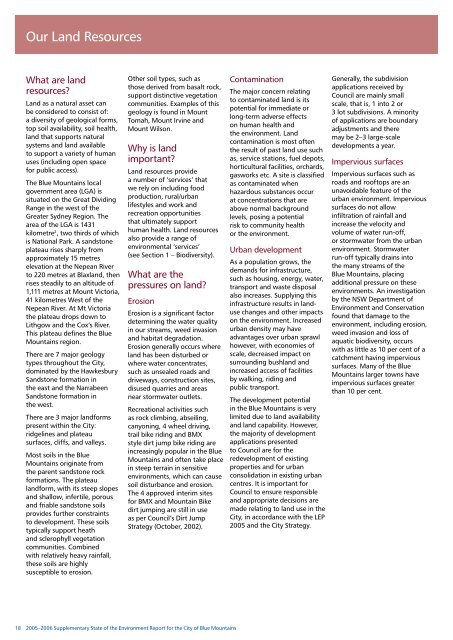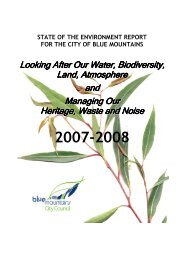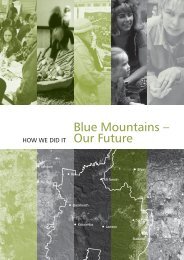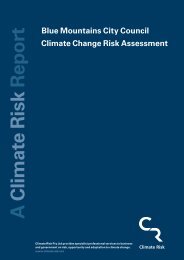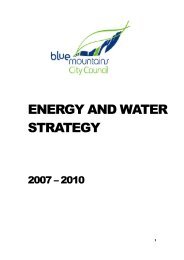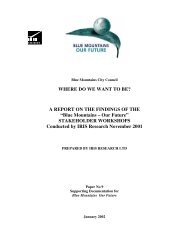State of the Environment Report for the City of Blue Mountains
State of the Environment Report for the City of Blue Mountains
State of the Environment Report for the City of Blue Mountains
You also want an ePaper? Increase the reach of your titles
YUMPU automatically turns print PDFs into web optimized ePapers that Google loves.
Our Land Resources<br />
What are land<br />
resources<br />
Land as a natural asset can<br />
be considered to consist <strong>of</strong>:<br />
a diversity <strong>of</strong> geological <strong>for</strong>ms,<br />
top soil availability, soil health,<br />
land that supports natural<br />
systems and land available<br />
to support a variety <strong>of</strong> human<br />
uses (including open space<br />
<strong>for</strong> public access).<br />
The <strong>Blue</strong> <strong>Mountains</strong> local<br />
government area (LGA) is<br />
situated on <strong>the</strong> Great Dividing<br />
Range in <strong>the</strong> west <strong>of</strong> <strong>the</strong><br />
Greater Sydney Region. The<br />
area <strong>of</strong> <strong>the</strong> LGA is 1431<br />
kilometre 2 , two thirds <strong>of</strong> which<br />
is National Park. A sandstone<br />
plateau rises sharply from<br />
approximately 15 metres<br />
elevation at <strong>the</strong> Nepean River<br />
to 220 metres at Blaxland, <strong>the</strong>n<br />
rises steadily to an altitude <strong>of</strong><br />
1,111 metres at Mount Victoria,<br />
41 kilometres West <strong>of</strong> <strong>the</strong><br />
Nepean River. At Mt Victoria<br />
<strong>the</strong> plateau drops down to<br />
Lithgow and <strong>the</strong> Cox’s River.<br />
This plateau defines <strong>the</strong> <strong>Blue</strong><br />
<strong>Mountains</strong> region.<br />
There are 7 major geology<br />
types throughout <strong>the</strong> <strong>City</strong>,<br />
dominated by <strong>the</strong> Hawkesbury<br />
Sandstone <strong>for</strong>mation in<br />
<strong>the</strong> east and <strong>the</strong> Narrabeen<br />
Sandstone <strong>for</strong>mation in<br />
<strong>the</strong> west.<br />
There are 3 major land<strong>for</strong>ms<br />
present within <strong>the</strong> <strong>City</strong>:<br />
ridgelines and plateau<br />
surfaces, cliffs, and valleys.<br />
Most soils in <strong>the</strong> <strong>Blue</strong><br />
<strong>Mountains</strong> originate from<br />
<strong>the</strong> parent sandstone rock<br />
<strong>for</strong>mations. The plateau<br />
land<strong>for</strong>m, with its steep slopes<br />
and shallow, infertile, porous<br />
and friable sandstone soils<br />
provides fur<strong>the</strong>r constraints<br />
to development. These soils<br />
typically support heath<br />
and sclerophyll vegetation<br />
communities. Combined<br />
with relatively heavy rainfall,<br />
<strong>the</strong>se soils are highly<br />
susceptible to erosion.<br />
O<strong>the</strong>r soil types, such as<br />
those derived from basalt rock,<br />
support distinctive vegetation<br />
communities. Examples <strong>of</strong> this<br />
geology is found in Mount<br />
Tomah, Mount Irvine and<br />
Mount Wilson.<br />
Why is land<br />
important<br />
Land resources provide<br />
a number <strong>of</strong> ‘services’ that<br />
we rely on including food<br />
production, rural/urban<br />
lifestyles and work and<br />
recreation opportunities<br />
that ultimately support<br />
human health. Land resources<br />
also provide a range <strong>of</strong><br />
environmental ‘services’<br />
(see Section 1 – Biodiversity).<br />
What are <strong>the</strong><br />
pressures on land<br />
Erosion<br />
Erosion is a significant factor<br />
determining <strong>the</strong> water quality<br />
in our streams, weed invasion<br />
and habitat degradation.<br />
Erosion generally occurs where<br />
land has been disturbed or<br />
where water concentrates,<br />
such as unsealed roads and<br />
driveways, construction sites,<br />
disused quarries and areas<br />
near stormwater outlets.<br />
Recreational activities such<br />
as rock climbing, abseiling,<br />
canyoning, 4 wheel driving,<br />
trail bike riding and BMX<br />
style dirt jump bike riding are<br />
increasingly popular in <strong>the</strong> <strong>Blue</strong><br />
<strong>Mountains</strong> and <strong>of</strong>ten take place<br />
in steep terrain in sensitive<br />
environments, which can cause<br />
soil disturbance and erosion.<br />
The 4 approved interim sites<br />
<strong>for</strong> BMX and Mountain Bike<br />
dirt jumping are still in use<br />
as per Council’s Dirt Jump<br />
Strategy (October, 2002).<br />
Contamination<br />
The major concern relating<br />
to contaminated land is its<br />
potential <strong>for</strong> immediate or<br />
long-term adverse effects<br />
on human health and<br />
<strong>the</strong> environment. Land<br />
contamination is most <strong>of</strong>ten<br />
<strong>the</strong> result <strong>of</strong> past land use such<br />
as, service stations, fuel depots,<br />
horticultural facilities, orchards,<br />
gasworks etc. A site is classified<br />
as contaminated when<br />
hazardous substances occur<br />
at concentrations that are<br />
above normal background<br />
levels, posing a potential<br />
risk to community health<br />
or <strong>the</strong> environment.<br />
Urban development<br />
As a population grows, <strong>the</strong><br />
demands <strong>for</strong> infrastructure,<br />
such as housing, energy, water,<br />
transport and waste disposal<br />
also increases. Supplying this<br />
infrastructure results in landuse<br />
changes and o<strong>the</strong>r impacts<br />
on <strong>the</strong> environment. Increased<br />
urban density may have<br />
advantages over urban sprawl<br />
however, with economies <strong>of</strong><br />
scale, decreased impact on<br />
surrounding bushland and<br />
increased access <strong>of</strong> facilities<br />
by walking, riding and<br />
public transport.<br />
The development potential<br />
in <strong>the</strong> <strong>Blue</strong> <strong>Mountains</strong> is very<br />
limited due to land availability<br />
and land capability. However,<br />
<strong>the</strong> majority <strong>of</strong> development<br />
applications presented<br />
to Council are <strong>for</strong> <strong>the</strong><br />
redevelopment <strong>of</strong> existing<br />
properties and <strong>for</strong> urban<br />
consolidation in existing urban<br />
centres. It is important <strong>for</strong><br />
Council to ensure responsible<br />
and appropriate decisions are<br />
made relating to land use in <strong>the</strong><br />
<strong>City</strong>, in accordance with <strong>the</strong> LEP<br />
2005 and <strong>the</strong> <strong>City</strong> Strategy.<br />
Generally, <strong>the</strong> subdivision<br />
applications received by<br />
Council are mainly small<br />
scale, that is, 1 into 2 or<br />
3 lot subdivisions. A minority<br />
<strong>of</strong> applications are boundary<br />
adjustments and <strong>the</strong>re<br />
may be 2–3 large-scale<br />
developments a year.<br />
Impervious surfaces<br />
Impervious surfaces such as<br />
roads and ro<strong>of</strong>tops are an<br />
unavoidable feature <strong>of</strong> <strong>the</strong><br />
urban environment. Impervious<br />
surfaces do not allow<br />
infiltration <strong>of</strong> rainfall and<br />
increase <strong>the</strong> velocity and<br />
volume <strong>of</strong> water run-<strong>of</strong>f,<br />
or stormwater from <strong>the</strong> urban<br />
environment. Stormwater<br />
run-<strong>of</strong>f typically drains into<br />
<strong>the</strong> many streams <strong>of</strong> <strong>the</strong><br />
<strong>Blue</strong> <strong>Mountains</strong>, placing<br />
additional pressure on <strong>the</strong>se<br />
environments. An investigation<br />
by <strong>the</strong> NSW Department <strong>of</strong><br />
<strong>Environment</strong> and Conservation<br />
found that damage to <strong>the</strong><br />
environment, including erosion,<br />
weed invasion and loss <strong>of</strong><br />
aquatic biodiversity, occurs<br />
with as little as 10 per cent <strong>of</strong> a<br />
catchment having impervious<br />
surfaces. Many <strong>of</strong> <strong>the</strong> <strong>Blue</strong><br />
<strong>Mountains</strong> larger towns have<br />
impervious surfaces greater<br />
than 10 per cent.<br />
18<br />
2005–2006 Supplementary <strong>State</strong> <strong>of</strong> <strong>the</strong> <strong>Environment</strong> <strong>Report</strong> <strong>for</strong> <strong>the</strong> <strong>City</strong> <strong>of</strong> <strong>Blue</strong> <strong>Mountains</strong>


